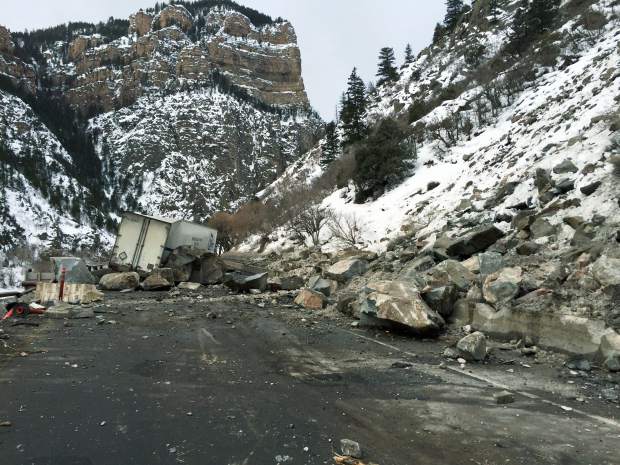 It was a beautiful summer day t Glacier Point in Yosemite National Park. The sky was azure blue, a blue that seems to be most vibrant up in the mountains. Having just arrived for a few days after working all week, I felt relaxed and happy to be up in the Sierra again. Chatting with my boyfriend, the earth suddenly started to shake, and the ground underneath me seemed to be vibrating. I immediately thought Earthquake! A huge roar and rumble rose up seemingly from inside the earth, followed by dust, dust and more dust. Clouds of dust were taking over what seemed like the entirety of Glacier Point, the spectacular promontory that overhung the Yosemite Valley.
It was a beautiful summer day t Glacier Point in Yosemite National Park. The sky was azure blue, a blue that seems to be most vibrant up in the mountains. Having just arrived for a few days after working all week, I felt relaxed and happy to be up in the Sierra again. Chatting with my boyfriend, the earth suddenly started to shake, and the ground underneath me seemed to be vibrating. I immediately thought Earthquake! A huge roar and rumble rose up seemingly from inside the earth, followed by dust, dust and more dust. Clouds of dust were taking over what seemed like the entirety of Glacier Point, the spectacular promontory that overhung the Yosemite Valley.
It all happened so fast, I wasn’t even sure what to do. I’d been in small earthquakes before while living in San Francisco, and knew what to do if you were inside. But what do you do when you’re standing outside?
I later found out that it wasn’t an earthquake, but really a rockslide, an incredibly large rockslide. Almost 162,000 tons of rock had fallen off the cliff directly below Glacier Point and collapsed into the valley near Happy Isles, a popular trailhead for hiking. Twelve people were injured and one was killed.
The thing I remember most vividly about the incident was the sound and the massive amount of dust. I later found out from friends camping in the valley, that the dust that exploded from the slide felt like a volcano erupting ash, spewing it all over, up to miles away. Campers said their picnic tables, gear, and food was coated in inches of ashen-looking dust, everywhere.
That incident brought home the force of mother nature and how powerful rockslides and landslides can be in mountainous areas. I was reminded of this once again by an incident here in Colorado this past week along one of the busiest interstates in the country, I-70. I-70 from Denver to the Utah border offers breathtaking scenery, including a 16-mile twisting and winding route through Glenwood Canyon. The Colorado River carved Glenwood Canyon, and water still makes it marks through waterfalls such as Hanging Falls and No Name Creek. Driving through it offers views of the massive granite walls, as well as the river’s rushing rapids.
But water can sculpt canyons in other ways, most evident during the winter and spring during freeze and thaw cycles. We’ve had unseasonably warm temperatures the past two weeks here in Colorado, with highs more than 20 degrees above normal. As the snow melts along the rugged mountains and canyons, it seeps into the cracks and fissures that permeate the rock. But though our days are warm, night-time temperatures still fall well below freezing and all that water freezes. When the water freezes, turning to ice, it expands and exerts enormous pressure on the rock — a process called ice wedging. Enough pressure, and the rock eventually succumbs, forcing enormous boulders to fall down the cliffs.
As you might imagine, over millions of years of geology, this process happens quite often. It’s sort of like the trees falling in the forest, and no one being there to witness it. However, now thousands of people travel through Glenwood Canyon, and so when a massive rockslide came down on Monday evening, crushing a trailer of a tractor-trailer, it was definitely felt and heard. Though a car and two trucks were caught in the slide, fortunately no one was hurt. But with I-70 serving as a main thoroughfare all the way from Washington, DC to western Utah, the ramifications of the highway being closed are great. The detour along Highway 40 to the north adds on almost 150 miles to the trip, and at great cost to truckers transporting goods. The road has been closed since Monday, and even though they hope to open one lane by the end of the weekend, delays will be significant, and it will probably be months until the highway is fully repaired.
Seeing these kind of events is not as uncommon as you might think. Here locally in Boulder Canyon, we have had similar rock slides, with boulders as large as cars crashing to the road. It reminds me once again how small us humans are, and try as we might to control nature, building roads through rugged canyons and mountains, ultimately the power of nature will exert its force, and we as people will have to adapt…

